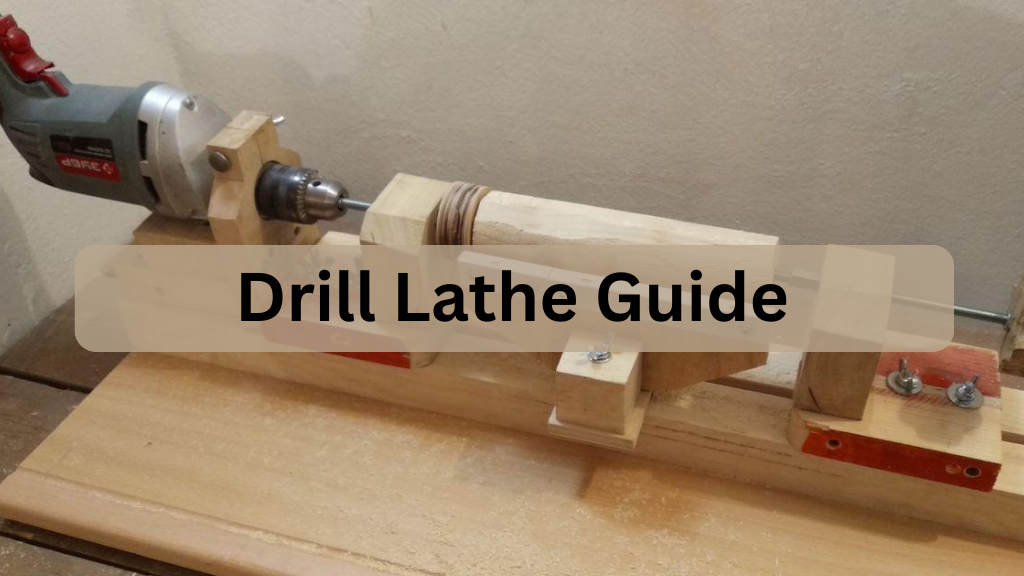A drill lathe is one of the most versatile tools for hobbyists, woodworkers, and small workshop owners who want the benefits of a lathe without the high cost of industrial machines. By transforming an ordinary power drill into a functional lathe, you can turn, shape, sand, and polish a wide variety of small projects. With the help of drill lathe attachments or kits, you can unlock the potential of your drill and explore woodworking, metalworking, or creative crafting at home.
This article explores everything you need to know about drill lathes, including attachments, kits, DIY builds, safety tips, buying advice, comparisons with traditional lathes, and answers to common questions.
What is a Drill Lathe
A drill lathe is a simple and versatile setup where a handheld drill is repurposed as the driving motor to rotate a workpiece. By mounting the drill onto a frame or stand and combining it with attachments such as a tool rest, tailstock, or chuck, it can perform many of the same functions as a traditional lathe. The drill supplies the rotational force, while the supporting components keep the material steady for safe and precise work.
Common Uses of a Drill Lathe
Although not as powerful as industrial machines, drill lathes are surprisingly effective for small-scale projects. They are most commonly used for:
- Woodturning projects: Shaping raw wood into round forms like spindles, knobs, handles, and chair legs.
- Polishing and sanding: Achieving smooth finishes on wooden pieces or even lightweight metal objects.
- Carving and shaping: Creating detailed designs and decorative elements on smaller materials.
- DIY crafts: Popular among hobbyists for making pens, toys, ornaments, and other custom items.
Drill Lathe Attachments
A drill lathe attachment is an accessory that transforms an ordinary drill into a functional lathe by securely mounting it onto a frame. With this setup, the drill acts as the motor while the attachment provides the stability and precision needed for turning workpieces. This makes attachments an excellent choice for hobbyists, woodworkers, and DIY enthusiasts who want to explore lathe work without investing in a full-sized machine.
Key Components of a Drill Lathe Attachment
A drill lathe attachment is only as effective as the parts that make it up. Each component plays an important role in ensuring safety, stability, and precision while turning a workpiece. Below are the core elements you’ll typically find in a drill lathe attachment:
- Frame or Base: The frame serves as the foundation of the entire setup. It holds the drill firmly in place and provides stability during operation. A strong, well-built base minimizes vibration, which is crucial for achieving smooth finishes and accurate cuts.
- Tailstock: The tailstock supports the opposite end of the workpiece. By keeping the material centered and balanced as it rotates, it prevents wobbling and ensures even shaping. This is especially important for longer or narrower pieces that require stability.
- Tool Rest: The tool rest acts as a guide for your chisels, knives, or carving tools. By giving you a solid point of support, it allows greater control over the cutting process, resulting in more precise shaping and safer operation.
- Clamp or Holder: The clamp secures the drill in place within the attachment. A reliable holder prevents the drill from shifting under pressure, which not only improves accuracy but also reduces the risk of accidents.
Types of Drill Lathe Attachments
Attachments vary widely in design and quality:
- Lightweight Attachments: Designed for small DIY projects such as crafting pens, knobs, or ornaments. They are affordable and portable, but less durable for heavy use.
- Heavy-Duty Attachments: Built with stronger materials like steel, these can handle slightly larger projects and offer improved stability. They are more suitable for hobbyists who plan to use their drill lathe regularly.
Why Use a Drill Lathe Attachment
- Affordable entry into lathe work compared to buying a traditional lathe
- Compact and space-saving for home workshops
- Easy to set up and compatible with most drills
- Versatile enough for woodworking, polishing, and light carving
By choosing the right attachment, you can unlock new possibilities for your drill and take on creative projects with greater precision.
Drill Lathe Kits
A drill lathe kit is a complete package designed to transform a standard power drill into a functional mini lathe. Instead of purchasing each part separately, these kits bundle together all the essential components, making them especially convenient for beginners, hobbyists, and DIY woodturners. By providing a ready-to-use setup, kits save both time and effort while ensuring compatibility between parts.
Key Components of Drill Lathe Kits
- Mounting Base for Stability: A solid base that holds the drill securely, reducing vibration and ensuring smooth operation.
- Tailstock with Adjustable Center: Provides support to the opposite end of the workpiece, keeping it balanced and aligned during rotation.
- Tool Rest with Adjustable Height: Serves as a guide for chisels or cutting tools, offering better control and accuracy while shaping the material.
- Mini Chuck or Mandrel: Allows you to hold and rotate smaller pieces of wood, metal, or acrylic for detailed projects.
- Sanding Discs or Grinding Wheels: Attachments for smoothing, sharpening, or refining surfaces.
Advanced Drill Lathe Kits
Some advanced kits go beyond the basics and include polishing wheels, engraving tools, buffing pads, and other accessories. These additions are ideal for specialized projects like jewelry making, metal polishing, or decorative woodworking.
Pricing of Drill Lathe Kits
Prices vary widely depending on build quality and included components.
- Entry-level kits: Budget-friendly and suitable for beginners or light hobby work.
- Mid-range kits: Offer sturdier construction, greater stability, and more precision-focused accessories for serious DIY projects.
DIY Drill Lathe
If you enjoy hands-on building, you can create a DIY drill lathe using materials like wood, steel brackets, and clamps. A homemade drill lathe is not only cost-effective but also customizable to your specific project needs.
Steps to make a DIY drill lathe:
- Build a sturdy base from wood or metal that can support your drill.
- Securely mount the drill to the base using clamps or custom brackets.
- Add a tailstock with a point to stabilize the other end of the workpiece.
- Install a tool rest for guiding chisels and blades safely.
- Test the setup with light cuts before moving on to heavier tasks.
DIY versions are popular among hobbyists because they encourage creativity, problem-solving, and customization. However, safety must be a top priority since homemade setups may not be as stable as commercial kits.
Benefits of Using a Drill Lathe
Drill lathes provide several advantages that make them appealing to beginners, hobbyists, and DIY enthusiasts. While they cannot fully replace industrial lathes, they offer an affordable and versatile option for learning lathe operations. Their compact design and flexibility make them a practical choice for small workshops or home projects.
-
Affordable Alternative
One of the biggest benefits of a drill lathe is its low cost compared to industrial machines. Full-sized lathes can be very expensive, often costing hundreds or even thousands of dollars. A drill lathe, however, is budget-friendly and accessible to beginners who want to experiment. This makes it a smart choice for hobbyists working on small projects.
-
Space-Saving Design
Drill lathes are compact and require very little workspace compared to large, heavy machines. This makes them perfect for garages, small workshops, or even hobby rooms at home. Their design ensures you can enjoy lathe operations without needing to dedicate an entire area. For those with limited space, this is a major advantage.
-
Portable and Lightweight
Unlike traditional lathes, which are heavy and difficult to move, drill lathes are light and portable. You can easily carry them around or shift them between different work areas. This mobility makes them useful for DIY enthusiasts who may not have a permanent setup. It also adds convenience for small hobby projects.
-
Versatile Functionality
A drill lathe is not limited to just one task—it can handle turning, sanding, polishing, and even grinding with the right attachments. This flexibility means you can use it for woodworking, light metalworking, or acrylic projects. Its multi-purpose nature allows hobbyists to try various techniques without investing in multiple machines.
-
Beginner-Friendly Setup
Drill lathes are simple to assemble and use, making them ideal for those just starting out. They provide an easy introduction to woodturning, shaping, and finishing projects. Because of their straightforward design, new users can quickly learn the basics of lathe operations. This makes them a stress-free entry point for beginners.
-
Stepping Stone to Full Lathes
For anyone considering investing in a full-size lathe later, a drill lathe is an excellent starting point. It allows you to build basic skills, understand tools, and gain confidence in handling projects. By practicing on a smaller setup, you prepare yourself for more advanced equipment. This progression saves both time and money in the long run.
Limitations of a Drill Lathe
While drill lathes are convenient and beginner-friendly, they do come with certain limitations. These restrictions make them better suited for light hobby work rather than heavy-duty or professional use. Understanding these drawbacks will help you decide if a drill lathe matches your specific project needs and expectations.
-
Less Powerful Than Traditional Lathes
A drill lathe relies on the motor of a hand drill, which is not as strong as the motors in industrial machines. This lack of power means it struggles with dense materials or large workpieces. The reduced torque can also affect precision during cutting or shaping. As a result, they are best used for light applications only.
-
Limited to Small and Lightweight Projects
Due to their compact size and weaker motor, drill lathes are only suitable for small-scale work. They can handle tasks like turning pens, polishing jewelry, or shaping softwood, but not heavy-duty projects. Attempting to work with large or hard materials may cause the drill to overheat. This limits their overall versatility.
-
Requires Careful Setup for Stability
Because of their lighter frames, drill lathes demand careful setup to remain stable. Even a small imbalance in the workpiece can cause vibrations or wobbling during operation. Users need to ensure the base is secured tightly before starting a project. Without proper stability, achieving smooth and accurate results becomes difficult.
-
Not Suitable for Professional Work
Professional workshops require tools that can withstand long hours and heavy loads, which drill lathes cannot provide. Their build quality is geared toward hobby use rather than commercial production. Using them in a professional setting could lead to frequent breakdowns. Therefore, they are not a replacement for full-sized lathes.
-
Can Vibrate More Than Industrial Machines
Since drill lathes are lightweight, they tend to vibrate more during operation, especially when handling harder materials. Excess vibration can impact the smoothness of the finish and reduce accuracy. This is one of the main drawbacks compared to heavier, industrial lathes. Hobbyists need to work slowly and carefully to minimize this issue.
Drill Lathe vs Traditional Lathe
| Feature | Drill Lathe | Traditional Lathe |
|---|---|---|
| Cost | Very affordable | Expensive investment |
| Size | Compact and portable | Large and heavy |
| Power | Limited, suitable for small projects | High power for industrial work |
| Versatility | Good for wood and light metals | Handles all materials |
| Precision | Moderate | Very high |
| Best For | Hobbyists and DIYers | Professionals and workshops |
A drill lathe cannot replace a traditional lathe for industrial or professional use, but it is perfect for small creative projects and learning.
Safety Tips for Using a Drill Lathe
Safety should always come first when working with a drill lathe. Since drills are not originally designed for lathe operations, extra care is required.
- Wear safety glasses and protective gloves
- Keep your workspace clear of clutter
- Make sure your drill is mounted securely
- Do not force the cutting tool into the workpiece
- Start at low speeds and increase gradually
- Avoid using oversized or heavy materials
- Always check that the workpiece is balanced before turning
Buying Guide: Choosing the Best Drill Lathe Attachment or Kit
When buying a drill lathe attachment or kit, consider the following factors:
- Compatibility with Your Drill: Ensure the attachment fits your drill’s size and chuck type.
- Material Quality: Look for sturdy frames made from steel or heavy-duty plastic.
- Stability: Choose options with secure clamps and a strong base.
- Accessories Included: Kits with multiple tools and rests offer more flexibility.
- Project Size: Match the kit’s capacity with your intended projects.
- Price vs Value: Balance affordability with durability and features.
Real-World Uses of Drill Lathes
Drill lathes are widely used in small workshops, hobbyist spaces, and even classrooms. Examples include:
- Woodworking Hobbyists: Creating custom pens, handles, spindles, and ornaments.
- DIY Crafters: Polishing small jewelry pieces or carving decorative designs.
- Repair Work: Fixing rounded edges, sanding, and polishing replacement parts.
- Educational Projects: Teaching students about rotational tools and mechanics.
Conclusion
A drill lathe is a practical and affordable tool for anyone interested in woodworking, metalworking, or DIY crafting. Whether you buy a ready-made drill lathe attachment, invest in a complete kit, or build your own DIY drill lathe, you gain the ability to create, shape, and polish small projects at home. While it cannot fully replace a traditional lathe, it offers excellent value for hobbyists and beginners who want to explore turning without a large financial commitment.
By understanding the different options, benefits, and safety practices, you can confidently start using a drill lathe for your creative projects.
FAQs
What can I make with a drill lathe
You can make pens, spindles, knobs, toys, decorative ornaments, and other small rounded objects.
Can I use any drill with a lathe kit
Most drills can be used as long as they fit securely into the attachment and have variable speed control.
Is a drill lathe suitable for metalworking
Drill lathes are mainly designed for woodworking, but they can handle light metals like aluminum with care.
How much does a drill lathe kit cost
Kits usually range from entry-level models around thirty dollars to more advanced sets priced at one hundred dollars or more.
Can a drill lathe replace a full lathe machine
No, drill lathes are ideal for hobby projects but not suitable for industrial-scale or precision professional work.




